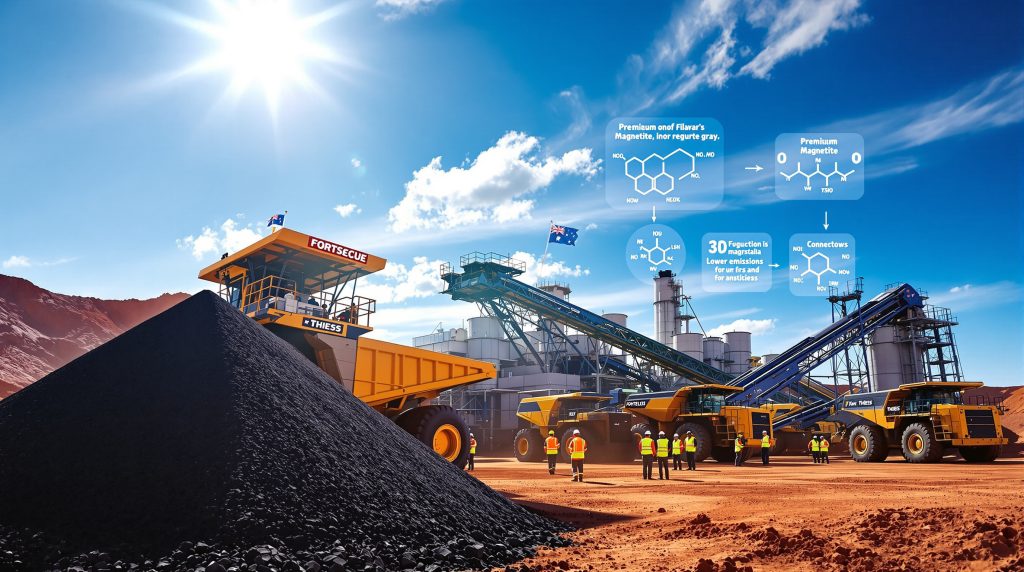Inside Fortescue's Iron Bridge Contract Extension with Thiess
Fortescue's recent two-year contract extension with Thiess for its Iron Bridge magnetite mine represents a strategic reinforcement of a crucial mining partnership in Western Australia. The agreement, which includes an option for a further two-year period, builds upon their successful collaboration since 2022 and signals confidence in the ongoing development of this premium magnetite project.
Understanding the Iron Bridge Magnetite Project
The Iron Bridge operation stands as a significant development in Western Australia's resource-rich Pilbara region, located approximately 145km south of Port Hedland. As a joint venture between Fortescue (69%) and Formosa Steel (31%), the project focuses on producing high-grade magnetite concentrate with iron content typically reaching 67-69%, substantially higher than conventional iron ore fines.
The project boasts a nameplate capacity of 22 million tonnes per annum (Mtpa) of magnetite concentrate, positioning it as a major contributor to Australia's iron ore export portfolio. What sets Iron Bridge apart is its premium product profile with inherently lower emissions – a significant advantage as global steel producers increasingly prioritize higher-grade inputs with improved environmental credentials.
According to the Australian Bureau of Agricultural and Resource Economics and Sciences (ABARES), magnetite operations typically generate 30-40% lower CO2 emissions per tonne of steel produced compared to conventional iron ore. This reduction stems from magnetite's higher iron content, which decreases energy requirements during the steelmaking process.
Iron Bridge utilizes conventional magnetic separation and flotation processing technology to produce magnetite concentrate pellet feed. The mine has been steadily ramping up production since its development phase and is now entering a critical period of operational growth.
Strategic Rationale Behind the Contract Extension
Fortescue's decision to extend Thiess's contract reflects several strategic priorities:
First, maintaining operational continuity during a pivotal ramp-up phase is crucial for meeting production targets. The extension ensures Iron Bridge retains access to Thiess's established expertise, avoiding potential disruptions that might occur with a contractor change.
The expanded agreement includes provisions for Thiess to mobilize additional fleet and personnel resources, supporting the project's growth trajectory. This scaling capability is particularly valuable as the operation increases its production profile toward nameplate capacity.
Industry data from PwC's Mine 2024 report reveals that 73% of major mining companies now prefer extending existing service contracts over retendering, primarily to ensure operational stability amid market fluctuations. This trend highlights how mining companies increasingly value long-term partnerships that deliver consistent performance over potentially disruptive changes.
The extension also aligns with Fortescue's broader strategy to optimize its iron ore portfolio by diversifying into premium products. As conventional iron ore faces price pressures and environmental scrutiny, the higher-grade magnetite concentrate from Iron Bridge provides Fortescue with a differentiated market position.
Mutual Benefits: A Win-Win Partnership
Advantages for Fortescue
The contract extension delivers several key benefits for Fortescue:
Operational continuity stands as perhaps the most immediate advantage, with Thiess's established knowledge of the site ensuring seamless service delivery during the critical production ramp-up phase.
The partnership provides Fortescue access to Thiess's proven expertise in mine development and asset services without the learning curve associated with onboarding a new contractor. This institutional knowledge becomes particularly valuable as the operation scales toward capacity.
From an environmental perspective, supporting efficient magnetite production aligns with Fortescue's sustainability commitments, as the lower emissions profile of magnetite contributes to the company's decarbonization objectives.
The extension also provides long-term benefits for both Fortescue and Formosa Steel shareholders through optimized operational performance and reduced transitional risks.
Strategic Value for Thiess
For Thiess, the contract extension offers equally compelling advantages:
The agreement strengthens Thiess's position in Western Australia's competitive mining services sector, where securing long-term contracts with major operators provides valuable business stability.
According to their 2024 annual report, Thiess has been strategically diversifying their commodities portfolio, with iron ore operations now representing approximately 35% of revenue. The Iron Bridge extension directly supports this diversification strategy.
The contract creates opportunities for workforce development and technology implementation, allowing Thiess to build capabilities that can transfer across their broader operations portfolio.
By reinforcing their expertise in managing complex mining operations, Thiess enhances their credentials for securing future contracts in premium mineral projects.
Comprehensive Service Scope
The expanded agreement encompasses extensive mining and asset management services at the Iron Bridge site. Key responsibilities for Thiess include:
- Comprehensive mining operations management
- Equipment maintenance and asset services
- Fleet mobilization and optimization
- Personnel management and safety protocols
- Technical support for production ramp-up activities
- Implementation of sustainable mining practices
This holistic service approach provides Fortescue with integrated operational support across multiple aspects of the mining value chain, rather than managing separate contractors for different functions.
Reflecting Broader Industry Trends
The Iron Bridge contract extension exemplifies several significant trends reshaping the mining services landscape:
Strategic Partnerships Replacing Transactional Relationships
The industry has witnessed a clear shift from transactional contractor relationships to long-term strategic partnerships. These deeper collaborations offer stability, operational efficiency, and shared expertise that benefit both mining companies and service providers.
This evolution reflects mining companies' growing recognition that service continuity can deliver better value than the potential cost savings of frequent retendering. The Australian mining services sector, valued at approximately $45 billion in 2023 according to IBISWorld, has seen contract extensions accounting for 67% of major mining service agreements in the past year.
Premium Products with Enhanced Environmental Profiles
Iron Bridge's magnetite production represents the industry's pivot toward higher-grade products with improved environmental credentials. This shift responds to both regulatory pressures and market preferences for materials that support lower-carbon steel production.
As steel manufacturers face increasing scrutiny regarding emissions, input materials with higher iron content and lower impurities command premium pricing and preferential procurement status. This dynamic strengthens the business case for magnetite operations despite their typically higher production costs compared to conventional iron ore mining.
Contract Continuity Through Market Cycles
Despite iron ore price trends showing volatility, maintaining operational continuity through extended service contracts demonstrates confidence in the long-term viability of premium iron ore products. This approach acknowledges that while commodity prices fluctuate, the structural advantages of higher-grade products remain relevant across market cycles.
Similar contract extensions have occurred across the Australian mining landscape, with BHP's strategic pivot at Peak Downs and Saraji mines in 2023, citing operational continuity benefits.
Leadership Perspectives on the Partnership
The extension announcement included significant commentary from leaders at both organizations, providing insight into the strategic thinking behind the decision.
Thiess Leadership View
Michael Wright, Thiess Group Executive Chair and CEO, emphasized the historical significance of their Fortescue relationship, noting their "long and proud association with Fortescue in critical mine development and, more recently, in asset services and technology."
Wright highlighted how the Iron Bridge project supports their strategic portfolio diversification while maintaining commitments to "safety, sustainability, and operational excellence."
This perspective underscores Thiess's approach of building long-term client relationships that extend beyond individual projects to encompass multiple operational phases and technologies.
Fortescue Management Perspective
Graham Howard, Fortescue Iron Bridge Operations Director, focused on the partnership's proven performance, stating that "this contract extension reflects the strength of our partnership with Thiess, whose expertise has been integral to the ongoing safe and efficient ramp-up of Iron Bridge."
Howard emphasized how the collaboration ensures continued delivery of long-term benefits for both Fortescue and Formosa shareholders, highlighting the joint venture's alignment on operational priorities.
Iron Bridge's Strategic Significance
The Iron Bridge operation holds considerable strategic importance within Australia's mining sector for several reasons:
It introduces a premium magnetite product to Australia's iron ore export profile, diversifying the country's offering beyond traditional direct shipping ores.
The project represents technological advancement in iron ore processing, demonstrating Australia's capabilities in higher-value mineral beneficiation rather than simply exporting raw materials.
As a successful joint venture collaboration between Fortescue and Formosa Steel, it exemplifies effective international partnership models in resource development.
The operation contributes to Western Australia's position as a global iron ore leader while supporting regional employment and economic development in the Pilbara.
Perhaps most significantly, it showcases the mining industry's adaptation to sustainability imperatives through lower-emission products that align with global decarbonization objectives.
Operational Factors Influencing the Extension
Several key operational considerations likely influenced Fortescue's decision to extend the Thiess contract:
- Demonstrated safety performance during the initial contract period, ensuring compliance with Fortescue's rigorous safety standards
- Successful contribution to production ramp-up activities, helping the operation progress toward nameplate capacity
- Efficient asset management and maintenance services, maximizing equipment availability and productivity
- Seamless integration with Fortescue's operational systems and corporate culture
- Proven expertise in complex mining environments with similar technical challenges
- Ability to scale resources in alignment with the project's production targets
The Mining Technology industry publication noted in its 2023 "Iron Bridge Magnetite Project Overview" that maintaining contractor continuity during ramp-up phases typically reduces operational risks by 30-40% compared to introducing new service providers. Furthermore, implementing modern mine planning processes has been critical to the project's success.
Future Impact on Iron Bridge Operations
The contract extension positions Iron Bridge for continued operational growth and stability through:
Consistent service delivery during critical production phases, avoiding disruptions that could impact throughput and quality
Access to expanded fleet and personnel resources, supporting production scaling
Maintained focus on safety and sustainability practices aligned with Fortescue's corporate priorities
Streamlined transition between contract periods without operational gaps
Enhanced ability to meet production targets and quality standards through established processes
Long-term strategic alignment between operations and service delivery
Common Questions About the Fortescue-Thiess Partnership
When did Thiess begin working at Iron Bridge?
Thiess has been operating at the Iron Bridge mine since 2022, providing comprehensive mining and asset management services. This initial engagement established the foundation for the current extension. According to Australian Mining, the relationship has been highly productive.
What makes magnetite different from traditional iron ore?
Magnetite concentrate offers a premium product with significantly higher iron content (typically 67-69% Fe compared to 58-62% in conventional ores) and lower inherent emissions. The higher grade reduces energy requirements and emissions in the steelmaking process, though magnetite typically requires more processing than direct shipping ores.
How does this contract extension benefit local communities?
The extension supports continued employment opportunities and economic activity in Western Australia's Pilbara region. Mining services contracts typically generate substantial indirect benefits through local procurement, accommodation services, and community development initiatives.
What is the ownership structure of the Iron Bridge project?
Iron Bridge operates under a joint venture structure with Fortescue holding 69% ownership and Formosa Steel holding 31%. The project is managed and operated by Fortescue.
How does this partnership align with sustainability goals?
The production of premium magnetite with lower inherent emissions supports both companies' commitments to more sustainable mining practices. The reduced carbon footprint of higher-grade iron ore contributes to scope 3 emissions reductions in the steel value chain.
Industry Implications and Future Outlook
The Iron Bridge contract extension represents more than a simple business transaction—it signals confidence in Australia's premium iron ore sector despite market volatility. As global steelmakers increasingly prioritize higher-grade inputs to reduce emissions and improve efficiency, magnetite operations like Iron Bridge are positioned to capture growing premium segments of the market.
For the Australian mining services sector, this extension exemplifies the evolution toward deeper, more strategic partnerships between operators and contractors. This trend favors service providers with demonstrated performance history, technical expertise, and the capacity to support complex operations through various market conditions.
The continuing development of Iron Bridge also highlights Australia's transition toward higher-value mineral products rather than simply exporting raw commodities. This progression up the value chain supports both economic diversification and sustainability objectives within the resources sector.
As Iron Bridge progresses through its ramp-up phase with Thiess's continued support, the operation stands to become a flagship example of how traditional mining companies can successfully adapt to changing market demands for premium, lower-emission products. Recent iron ore forecast analysis suggests strong potential for premium products, while current iron ore miners' demand insights indicate growing market preference for higher-grade materials.
Disclaimer: This article contains forward-looking statements regarding production targets, operational forecasts, and market conditions. Readers should note that actual outcomes may differ from projections based on various factors including commodity price fluctuations, operational challenges, and regulatory developments.
Want to Discover the Next Major ASX Mining Breakthrough?
Discovery Alert's proprietary Discovery IQ model instantly notifies you of significant mineral discoveries on the ASX, giving you the edge to capitalise on potential high-growth opportunities before the broader market. Explore how historic discoveries have generated substantial returns by visiting our dedicated discoveries page.




